Global Long Read Sequencing Market By Product Type, By Technology, By Application, By End User, By Region & Segmental Insights Trends and Forecast, 2024 – 2034
- Industry: Healthcare
- Report ID: TNR-110-1267
- Number of Pages: 420
- Table/Charts : Yes
- August, 2024
- Base Year : 2024
- No. of Companies : 10+
- No. of Countries : 29
- Views : 10042
- Covid Impact Covered: Yes
- War Impact Covered: Yes
- Formats : PDF, Excel, PPT
Long read sequencing, also known as third-generation sequencing, refers to advanced genomic technologies that produce longer sequences of DNA, offering higher accuracy and better resolution in mapping complex genomes compared to traditional short-read methods. This technology is pivotal in identifying structural variations, repetitive sequences, and large-scale genomic rearrangements that are challenging to detect with short reads.
According to recent statistics, the global long read sequencing market was valued at approximately USD 1.4 Bn in 2023 projected to reach USD 15.3 Bn by 2034; expected to grow at a CAGR of 24.6% from 2024 to 2034. The global long read sequencing market is experiencing robust growth, driven by increasing demand for precise genetic analysis in healthcare, research, and biotechnology. Technological advancements, coupled with expanding applications in personalized medicine and disease diagnostics, are further fueling market expansion, making it a critical segment in the genomics landscape.
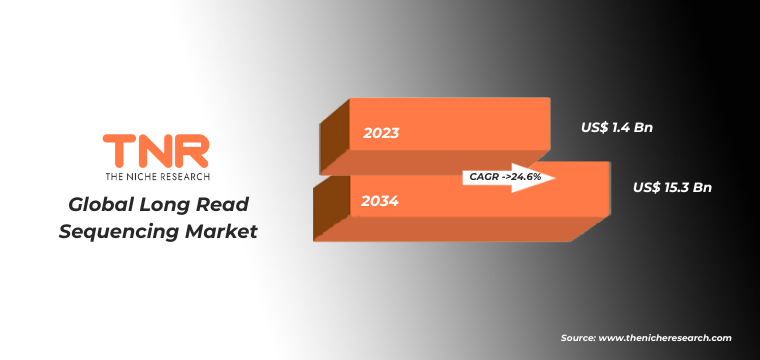
Global Long Read Sequencing Market Dynamics
Global Long Read Sequencing Market Growth Driver:
- Technological Advancements: Continuous innovations in sequencing technologies are enhancing accuracy, speed, and cost-efficiency, making long read sequencing more accessible for research and clinical applications, thereby driving market growth.
- Rising Demand for Precision Medicine: Increasing emphasis on personalized healthcare is boosting the adoption of long read sequencing, as it provides comprehensive genomic insights crucial for tailored treatment strategies and early disease detection, fueling market expansion.
Global Long Read Sequencing Market Restraint:
- High Costs: The substantial expense associated with long read sequencing technologies, including equipment and consumables, limits adoption, particularly in resource-constrained settings, restraining the market’s growth potential.
- Technical Complexity: The advanced nature of long read sequencing requires specialized skills and infrastructure, posing challenges for widespread implementation in laboratories and clinical settings, thereby hindering broader market penetration.
Global Long Read Sequencing Market Opportunity:
- Expanding Clinical Applications: The increasing exploration of long read sequencing in disease diagnostics and personalized medicine opens new avenues for market growth, as its ability to detect complex genetic variations becomes more critical in clinical settings.
- Emerging Markets: Growing healthcare investments and research initiatives in emerging economies present significant opportunities for long read sequencing market expansion, as these regions seek advanced genomic solutions to address diverse health challenges.
Global Long Read Sequencing Market Trends:
- Integration with AI and Bioinformatics: The trend of integrating long read sequencing with artificial intelligence and advanced bioinformatics tools is enhancing data analysis, improving accuracy, and accelerating the discovery of novel genetic insights, driving market innovation.
- Adoption in Cancer Research: There is a growing trend of utilizing long read sequencing in oncology research, where its ability to accurately identify structural variations and mutations is proving essential for advancing cancer diagnostics and targeted therapies.
Global Long Read Sequencing Market Segmental Analysis:
Global Long Read Sequencing Market By Product Type
Instruments segment, by product type, is anticipated to lead the global long read sequencing market in the coming years. This dominance is attributed to continuous technological advancements in sequencing instruments, which are crucial for enhancing the accuracy, speed, and efficiency of long read sequencing processes. The increasing demand for sophisticated instruments in research and clinical settings, driven by the need for precise genetic analysis, is further fueling this segment’s growth. Additionally, the expansion of applications in areas such as cancer research, rare disease diagnostics, and personalized medicine is expected to sustain the demand for advanced sequencing instruments, solidifying their market leadership.
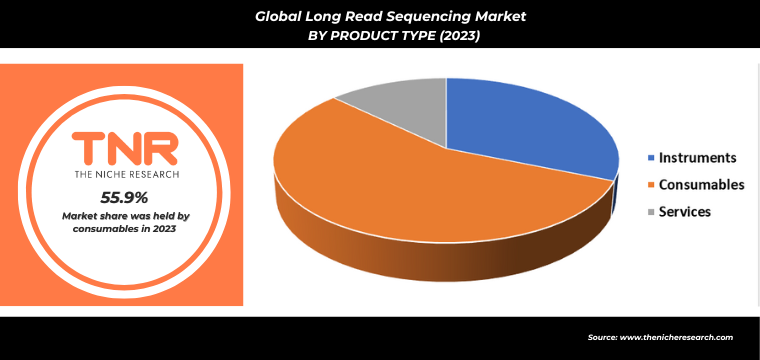
Global Long Read Sequencing Market By Technology
In 2023, nanopore sequencing technology dominated the global long read sequencing market due to its unique ability to sequence long stretches of DNA in real-time, offering unparalleled flexibility and scalability. This technology uses nanopores—tiny holes—embedded in a membrane to read DNA sequences by detecting changes in ionic current as DNA strands pass through the pores. Unlike other sequencing technologies, such as PacBio’s Single-Molecule Real-Time (SMRT) sequencing, which relies on optical detection, nanopore sequencing provides real-time data, portability, and the ability to sequence both short and long fragments of DNA without requiring complex sample preparation. These advantages have driven its widespread adoption.
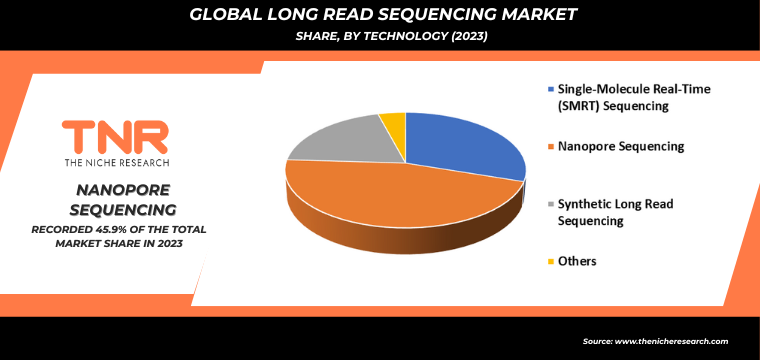
Global Long Read Sequencing Market By Application
Epigenetics, the study of heritable changes in gene expression that do not involve alterations to the underlying DNA sequence, is poised to significantly accelerate the global long read sequencing market in the coming years. This field focuses on understanding how factors like DNA methylation, histone modification, and non-coding RNA affect gene activity. Long read sequencing is particularly well-suited for epigenetic research because of its ability to capture complex regions of the genome and detect epigenetic modifications with high accuracy. As the demand for comprehensive epigenetic insights grows in areas such as cancer research and personalized medicine, long read sequencing will see increased adoption and market growth.
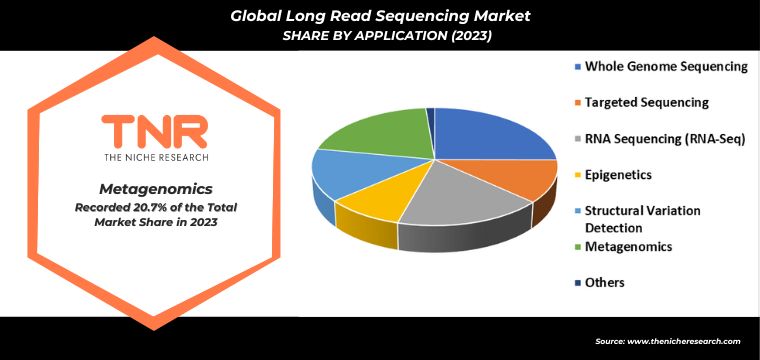
Global Long Read Sequencing Market By End User
Academic and research institutes are the leading end users of long read sequencing in the global market. These institutions drive demand due to their focus on advanced genomic research, including studies on complex diseases, evolutionary biology, and epigenetics. The capability of long read sequencing to provide high-resolution, accurate genomic data, particularly in challenging regions of the genome, is crucial for these research endeavors. Additionally, academic and research institutes often have access to funding and grants that support the acquisition of cutting-edge sequencing technologies, enabling them to conduct in-depth studies that require the precision and comprehensiveness that long read sequencing offers.
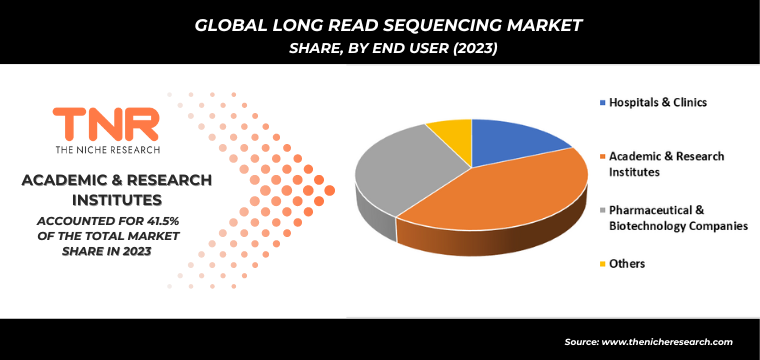
Global Long Read Sequencing Market By Region
North America held regional dominance in the global long read sequencing market, largely due the region’s advanced healthcare infrastructure, significant investment in genomic research, and the presence of leading biotechnology and pharmaceutical companies. The United States, in particular, has been at the forefront of adopting cutting-edge sequencing technologies, driven by strong government support through initiatives like the Precision Medicine Initiative and substantial funding from agencies such as the National Institutes of Health (NIH). Additionally, the region benefits from a robust ecosystem of academic and research institutions that actively utilize long read sequencing for a wide range of applications, further solidifying North America’s leadership in this rapidly growing market.
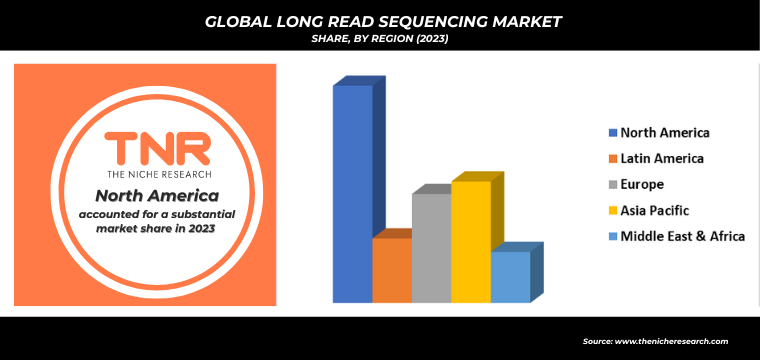
Competitive Landscape
The competitive landscape of the global long read sequencing market features key players like Oxford Nanopore Technologies and PacBio, driving innovation through advanced technologies. Companies compete on technological advancements, product performance, and strategic collaborations to capture market share.
Recent Developments:
- In May 2022, Oxford Nanopore Technologies introduced the GridION X5 system, a high-throughput platform for long read sequencing. This system enables the simultaneous sequencing of up to five flow cells, enhancing both throughput and scalability for various applications.
- In July 2022, Pacific Biosciences (PacBio) unveiled the Sequel IIIe System, the newest iteration of its long read sequencing technology. This system offers enhanced performance with improved read length, accuracy, and throughput, allowing researchers to investigate complex genomic regions with greater precision.
Some of the players operating in the long read sequencing market are
- 10x Genomics, Inc.
- Agilent Technologies, Inc.
- BGI Genomics Co., Ltd.
- Biomatters Ltd.
- Bio-Rad Laboratories, Inc.
- Hoffmann-La Roche Ltd.
- GenapSys Inc.
- GENEWIZ
- Genia Technologies, Inc.
- Illumina, Inc.
- MGI Tech Co., Ltd.
- Nabsys, Inc.
- Oxford Nanopore Technologies Ltd.
- Pacific Biosciences of California, Inc.
- Paragon Genomics, Inc.
- PerkinElmer, Inc.
- Qiagen N.V.
- Roche Holding AG
- Thermo Fisher Scientific Inc.
- ZS Genetics, Inc.
- Other Industry Participants
Global Long Read Sequencing Market Scope:
| Report Specifications | Details |
| Market Revenue in 2023 | US$ 1.4 Bn |
| Market Size Forecast by 2034 | US$ 15.3 Bn |
| Growth Rate (CAGR) | 24.6% |
| Historic Data | 2016 – 2022 |
| Base Year for Estimation | 2023 |
| Forecast Period | 2024 – 2034 |
| Report Inclusions | Market Size & Estimates, Market Dynamics, Competitive Scenario, Trends, Growth Factors, Market Determinants, Key Investment Segmentation, Product/Service/Solutions Benchmarking |
| Segments Covered | By Product Type, By Technology, By Application, By End User, By Region |
| Regions Covered | North America, Europe, Asia Pacific, Middle East & Africa, Latin America |
| Countries Covered | U.S., Canada, Mexico, Rest of North America, France, The UK, Spain, Germany, Italy, Nordic Countries (Denmark, Finland, Iceland, Sweden, Norway), Benelux Union (Belgium, The Netherlands, Luxembourg), Rest of Europe, China, Japan, India, New Zealand, Australia, South Korea, Southeast Asia (Indonesia, Thailand, Malaysia, Singapore, Rest of Southeast Asia), Rest of Asia Pacific, Saudi Arabia, UAE, Egypt, Kuwait, South Africa, Rest of Middle East & Africa, Brazil, Argentina, Rest of Latin America |
| Key Players | 10x Genomics, Inc., Agilent Technologies, Inc., BGI Genomics Co., Ltd., Biomatters Ltd., Bio-Rad Laboratories, Inc., F. Hoffmann-La Roche Ltd., GenapSys Inc., GENEWIZ, Genia Technologies, Inc., Illumina, Inc., MGI Tech Co., Ltd., Nabsys, Inc., Oxford Nanopore Technologies Ltd., Pacific Biosciences of California, Inc., Paragon Genomics, Inc., PerkinElmer, Inc., Qiagen N.V., Roche Holding AG, Thermo Fisher Scientific Inc., ZS Genetics, Inc. |
| Customization Scope | Customization allows for the inclusion/modification of content pertaining to geographical regions, countries, and specific market segments. |
| Pricing & Procurement Options | Explore purchase options tailored to your specific research requirements |
| Contact Details | Consult With Our Expert
Japan (Toll-Free): +81 663-386-8111 South Korea (Toll-Free): +82-808- 703-126 Saudi Arabia (Toll-Free): +966 800-850-1643 United Kingdom: +44 753-710-5080 United States: +1 302-232-5106 E-mail: askanexpert@thenicheresearch.com
|
Global Long Read Sequencing Market Segmentation:
By Product Type
- Instruments
- Consumables
- Services
By Technology
- Single-Molecule Real-Time (SMRT) Sequencing
- Nanopore Sequencing
- Synthetic Long Read Sequencing
- Others
By Application
- Whole Genome Sequencing
- Targeted Sequencing
- RNA Sequencing (RNA-Seq)
- Epigenetics
- Structural Variation Detection
- Metagenomics
- Others
By End User
- Hospitals & Clinics
- Academic & Research Institutes
- Pharmaceutical & Biotechnology Companies
- Others
By Region
- North America (U.S., Canada, Mexico, Rest of North America)
- Europe (France, The UK, Spain, Germany, Italy, Nordic Countries (Denmark, Finland, Iceland, Sweden, Norway), Benelux Union (Belgium, The Netherlands, Luxembourg), Rest of Europe)
- Asia Pacific (China, Japan, India, New Zealand, Australia, South Korea, Southeast Asia (Indonesia, Thailand, Malaysia, Singapore, Rest of Southeast Asia), Rest of Asia Pacific)
- Middle East & Africa (Saudi Arabia, UAE, Egypt, Kuwait, South Africa, Rest of Middle East & Africa)
- Latin America (Brazil, Argentina, Rest of Latin America)
Report Layout:
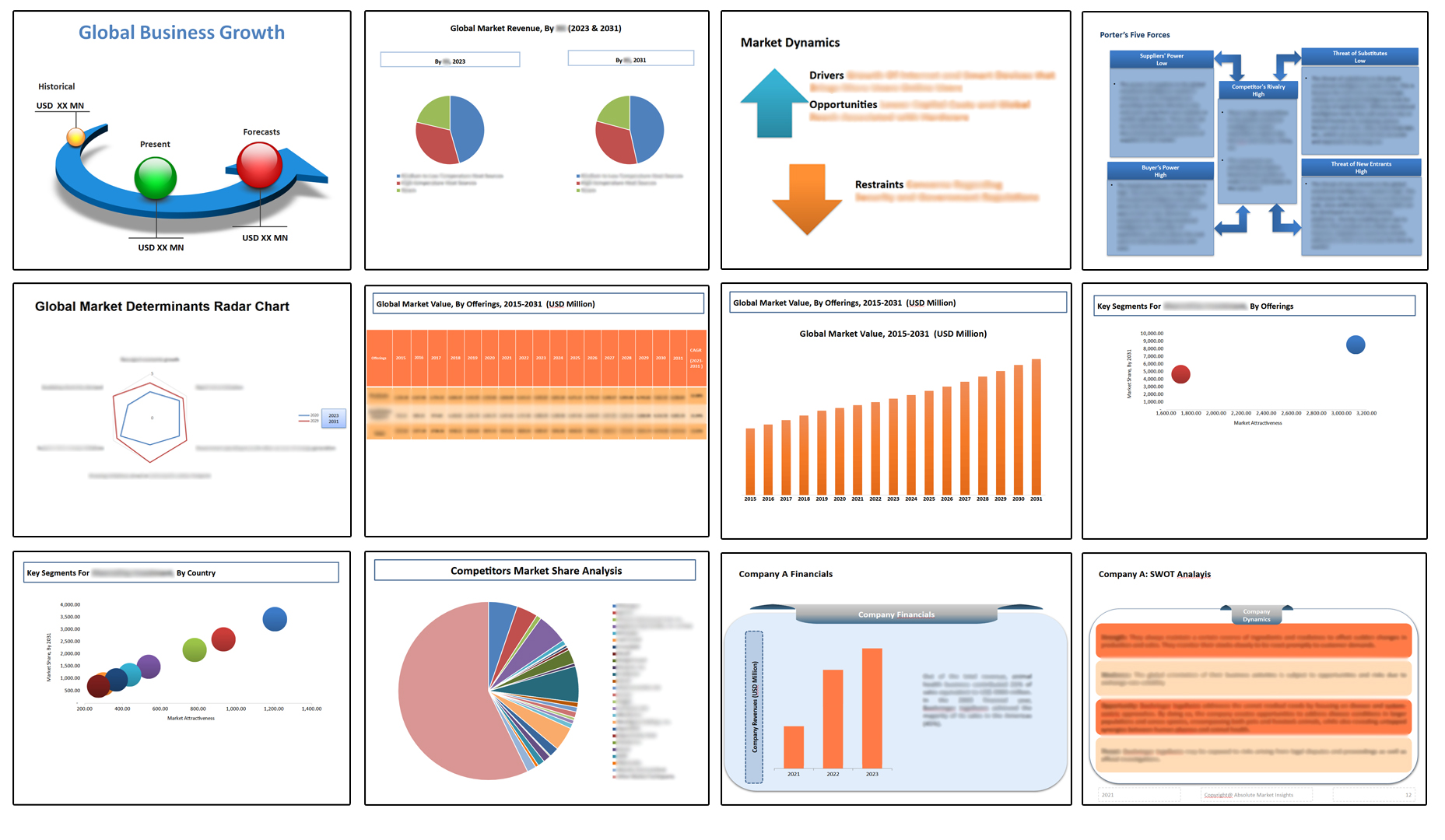
Table of Contents
Note: This ToC is tentative and can be changed according to the research study conducted during the course of report completion.
**Exclusive for Multi-User and Enterprise User.
Global Long Read Sequencing Market Segmentation:
By Product Type
- Instruments
- Consumables
- Services
By Technology
- Single-Molecule Real-Time (SMRT) Sequencing
- Nanopore Sequencing
- Synthetic Long Read Sequencing
- Others
By Application
- Whole Genome Sequencing
- Targeted Sequencing
- RNA Sequencing (RNA-Seq)
- Epigenetics
- Structural Variation Detection
- Metagenomics
- Others
By End User
- Hospitals & Clinics
- Academic & Research Institutes
- Pharmaceutical & Biotechnology Companies
- Others
By Region
- North America (U.S., Canada, Mexico, Rest of North America)
- Europe (France, The UK, Spain, Germany, Italy, Nordic Countries (Denmark, Finland, Iceland, Sweden, Norway), Benelux Union (Belgium, The Netherlands, Luxembourg), Rest of Europe)
- Asia Pacific (China, Japan, India, New Zealand, Australia, South Korea, Southeast Asia (Indonesia, Thailand, Malaysia, Singapore, Rest of Southeast Asia), Rest of Asia Pacific)
- Middle East & Africa (Saudi Arabia, UAE, Egypt, Kuwait, South Africa, Rest of Middle East & Africa)
- Latin America (Brazil, Argentina, Rest of Latin America)
The Niche Research approach encompasses both primary and secondary research methods to provide comprehensive insights. While primary research is the cornerstone of our studies, we also incorporate secondary research sources such as company annual reports, premium industry databases, press releases, industry journals, and white papers.
Within our primary research, we actively engage with various industry stakeholders, conducting paid interviews and surveys. Our meticulous analysis extends to every market participant in major countries, allowing us to thoroughly examine their portfolios, calculate market shares, and segment revenues.
Our data collection primarily focuses on individual countries within our research scope, enabling us to estimate regional market sizes. Typically, we employ a bottom-up approach, meticulously tracking trends in different countries. We analyze growth drivers, constraints, technological innovations, and opportunities for each country, ultimately arriving at regional figures.Our process begins by examining the growth prospects of each country. Building upon these insights, we project growth and trends for the entire region. Finally, we utilize our proprietary model to refine estimations and forecasts.
Our data validation standards are integral to ensuring the reliability and accuracy of our research findings. Here’s a breakdown of our data validation processes and the stakeholders we engage with during our primary research:
- Supply Side Analysis: We initiate a supply side analysis by directly contacting market participants, through telephonic interviews and questionnaires containing both open-ended and close-ended questions. We gather information on their portfolios, segment revenues, developments, and growth strategies.
- Demand Side Analysis: To gain insights into adoption trends and consumer preferences, we reach out to target customers and users (non-vendors). This information forms a vital part of the qualitative analysis section of our reports, covering market dynamics, adoption trends, consumer behavior, spending patterns, and other related aspects.
- Consultant Insights: We tap into the expertise of our partner consultants from around the world to obtain their unique viewpoints and perspectives. Their insights contribute to a well-rounded understanding of the markets under investigation.
- In-House Validation: To ensure data accuracy and reliability, we conduct cross-validation of data points and information through our in-house team of consultants and utilize advanced data modeling tools for thorough verification.
The forecasts we provide are based on a comprehensive assessment of various factors, including:
- Market Trends and Past Performance (Last Five Years): We accurately analyze market trends and performance data from preceding five years to identify historical patterns and understand the market’s evolution.
- Historical Performance and Growth of Market Participants: We assess the historical performance and growth trajectories of key market participants. This analysis provides insights into the competitive landscape and individual company strategies.
- Market Determinants Impact Analysis (Next Eight Years): We conduct a rigorous analysis of the factors that are projected to influence the market over the next eight years. This includes assessing both internal and external determinants that can shape market dynamics.
- Drivers and Challenges for the Forecast Period:Identify the factors expected to drive market growth during the forecast period, as well as the challenges that the industry may face. This analysis aids in deriving an accurate growth rate projection.
- New Acquisitions, Collaborations, or Partnerships: We keep a close watch on any new acquisitions, collaborations, or partnerships within the industry. These developments can have a significant impact on market dynamics and competitiveness.
- Macro and Micro Factors Analysis:A thorough examination of both macro-level factors (e.g., economic trends, regulatory changes) and micro-level factors (e.g., technological advancements, consumer preferences) that may influence the market during the forecast period.
- End-User Sentiment Analysis: To understand the market from the end-user perspective, we conduct sentiment analysis. This involves assessing the sentiment, preferences, and feedback of the end-users, which can provide valuable insights into market trends.
- Perspective of Primary Participants: Insights gathered directly from primary research participants play a crucial role in shaping our forecasts. Their perspectives and experiences provide valuable qualitative data.
- Year-on-Year Growth Trend: We utilize a year-on-year growth trend based on historical market growth and expected future trends. This helps in formulating our growth projections, aligning them with the market’s historical performance.
Research process adopted by TNR involves multiple stages, including data collection, validation, quality checks, and presentation. It’s crucial that the data and information we provide add value to your existing market understanding and expertise. We have also established partnerships with business consulting, research, and survey organizations across regions and globally to collaborate on regional analysis and data validation, ensuring the highest level of accuracy and reliability in our reports.









